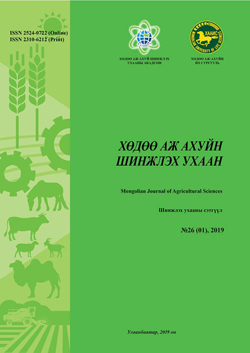The study on inheritance pattern, phenotype and nutritional analysis of atgrf2 transgenic rapeseed (brassica napus. L)
DOI:
https://doi.org/10.5564/mjas.v26i01.1203Keywords:
Hygromycin tolerance, gus geneAbstract
The rapeseed (Brassica napus L.) is the third most important economic plant in the world, from rapeseeds to oils and biodiesel. The results of previous studies have determined that possibilities to increase seed yield via increasing the size of the green leaf and the photosynthetic intensity. Therefore, the aims of this study to determine an inheritance pattern of transgene to T1 progeny, to compare phenotype of wild type and transgenic plants and to detect and compare some nutritional values of wild type and transgenic. Rapeseed seed surface was washed with 10% sodium hypochlorite for 10 min and rinse with sterile distilled water 3 times. T1 genetic inheritages were 3:1 to Mendelian ratio means 1 copy number of transgene was integrated into rapeseed genome. The height of AtGRF2 transgenic plants 25% higher than that if wild type plants, long shaft was 37.5%, leaf length was 31.6%, leaf width was 28.1%, and leaf area was increased by 34.8% than wild type plants. The total protein content of the transgenic plants 0.5% higher than that of the whole wild type plant, the total amount of the dietary fiber was the same, and the calcium content was 1.7% lower. About calcium, total ash, organic matter and total fat contents were very little difference. From the results, we concluded that the nutritional value of transgenic and wild type rapeseed plants was not shown significant differences.
Atgrf2 ген шилжүүлэн суулгасан рапс (brassica napus l.) -ын удамшил, фенотип, шимт чанарын зарим үзүүлэлтийн судалгаа
Хураангуй Рапс (Brassica napus L.) нь дэлхийд 3-рт ордог эдийн засгийн чухал ач холбогдолтой таримал ургамал бөгөөд рапсаас хүнсний тос, биодизел гарган авдаг. Рапсын тосыг үрээс нь ялган авдаг ба ургамлын ногоон навчны хэмжээ, фотосинтезийн эрчмийг нэмэгдүүлснээр үрийн гарц, хэмжээг нэмэгдүүлсэн судалгааны дүнгүүд байдаг. Иймээс энэхүү судалгаагаар ургамлын өсөлтийг идэвхжүүлэгч AtGRF2 (Arabidopsis thaliana growth-regulating factor2) ген шилжүүлэн суулгасан рапс (Brassica napus L.) -ны удамшил, фенотип, шимт чанарын зарим үзүүлэлтийг тодорхойлох зорилго тавилаа. Рапсын үрийн гадаргууг 10%-ийн гипохлорид натрийн уусмалаар 10 мин угааж, ариутгасан нэрмэл усаар 3 удаа зайлж ариутгав. Антибиотикт тэсвэрлэх тохиромжтой хувилбар 30 мкл гигромицинт тэжээлт орчинд Т1 удмын үрийг ургуулж антибиотикт тэсвэрлэх чанараар AtGRF2 генийн удамшлын тооцоолон үзэхэд Т1-д генийн удамшил Менделийн хуулийн дагуу 3:1 байв. AtGRF2 ген шилжин орсон трансген рапсын ургамлын навчны хэмжээг эх ургамалтай харьцуулан үзэхэд трансген ургамлын өндөр хяналтаас 25%-иар, зайдмалын урт 37,5%-иар, зайдмалын тоо 18,8% навчны урт 31,6%-иар, навчны өргөн 28,1%-иар, навчны талбай 34,8%-иар томорсон байна.Трансген рапсанд агуулагдах фосфор, азотгүй хандлаг бодис (АХБ), нийт үнс, органик бодис, нийт тослогийн хэмжээ нь эх ургамлынхаас маш бага зөрөөтэй харин нийт уураг эх ургамлаасаа маш бага буюу 0,5%-иар их, нийт эслэгийн хэмжээ ижил, харин кальцийн хэмжээ 1,7%-иар бага байгаа нь трансген рапс шимт чанарын хувьд эх ургамалтай маш төстэй болохыг харуулж байна.
Түлхүүр үг: Гигромицин тэсвэр, gus ген
Downloads
709
Downloads
Published
How to Cite
Issue
Section
License
Copyright on any research article in the Mongolian Journal of Agricultural Sciences is retained by the author(s).
The authors grant the Mongolian Journal of Agricultural Sciences a license to publish the article and identify itself as the original publisher.

Articles in the Mongolian Journal of Agricultural Sciences are Open Access articles published under a Creative Commons Attribution 4.0 International License CC BY.
This license permits use, distribution and reproduction in any medium, provided the original work is properly cited.




